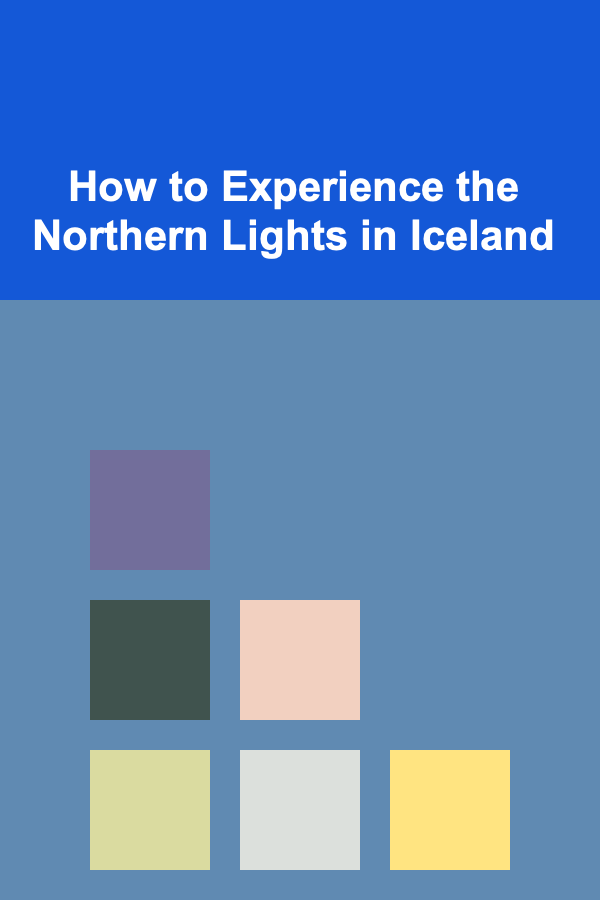
How to Experience the Northern Lights in Iceland
ebook include PDF & Audio bundle (Micro Guide)
$12.99$9.99
Limited Time Offer! Order within the next:

The Northern Lights, also known as the Aurora Borealis, are one of nature's most mesmerizing phenomena. The vibrant colors that dance across the night sky have captivated people for centuries. Iceland, with its dramatic landscapes and unique location, is one of the best places on Earth to witness this stunning light show. In this article, we'll guide you through everything you need to know to experience the Northern Lights in Iceland, from understanding the science behind them to the best locations, times, and tips for maximizing your chances of seeing them.
Understanding the Northern Lights
Before delving into how to experience the Northern Lights in Iceland, it's essential to understand what causes this incredible natural light show. The Northern Lights occur when charged particles from the sun collide with atoms and molecules in the Earth's atmosphere. This interaction excites the atoms, causing them to release energy in the form of light. These particles are funneled toward the poles by the Earth's magnetic field, where they create the dazzling displays we see as the Northern Lights.
The colors of the Aurora Borealis depend on the type of gas involved in the reaction and the altitude at which the interaction occurs. Oxygen at high altitudes (above 150 kilometers) produces red and green hues, while nitrogen can produce purple or blue colors. The interplay of these colors creates the spectacular displays that vary in intensity and shape.
Why Iceland?
Iceland's unique geography and location make it one of the prime spots for Northern Lights viewing. Located just below the Arctic Circle, Iceland offers clear, dark skies, especially during the winter months, which are essential for observing the lights. The country also boasts an abundance of natural wonders, such as glaciers, volcanoes, and hot springs, which make it an attractive destination for travelers in addition to being a top Aurora viewing spot.
The Ideal Time to See the Northern Lights in Iceland
The Northern Lights are most visible from late September to early April. During these months, the long nights and clear skies of Iceland provide optimal conditions for viewing. The further you are from artificial light, the better your chances of seeing the Aurora. In Iceland, this means venturing away from the capital, Reykjavik, or other major towns to areas that offer little to no light pollution.
December, January, and February are the darkest months, providing the longest nights, which increases the chances of spotting the lights. However, this is also when the weather is at its coldest, with temperatures often plunging below freezing. November and March are also excellent times to visit, as they offer a good balance of relatively milder temperatures while still providing long, dark nights.
Weather Conditions and Aurora Forecasting
While Iceland is known for its unpredictable weather, the Northern Lights are best viewed under clear skies with little to no cloud cover. Cloudy nights can obstruct the view, so it's important to monitor the weather forecast and the Aurora forecast. Fortunately, there are several websites and apps, such as the Icelandic Meteorological Office and Aurora Forecast, that provide real-time updates on both weather conditions and Aurora activity.
In addition to cloud cover, the lights are also best viewed when solar activity is high. Solar flares and sunspots increase the number of charged particles reaching Earth, leading to more vibrant displays. You can check space weather websites for information on solar activity and whether there's a good chance of Aurora sightings during your trip.
Best Locations to View the Northern Lights in Iceland
Iceland is small in size but packed with remarkable locations where you can catch the Northern Lights. These spots are far from the artificial light of major towns and offer vast open spaces where you can enjoy the full beauty of the Aurora Borealis.
1. Thingvellir National Park
A UNESCO World Heritage Site, Thingvellir National Park is not only historically and geologically significant but also offers fantastic conditions for Northern Lights viewing. Located about 40 kilometers from Reykjavik, the park is far enough from city lights to provide clear skies for Aurora sightings. The park is known for its striking landscapes, including rift valleys, lava fields, and crystal-clear lakes, which create a beautiful backdrop for the Northern Lights.
2. Jökulsárlón Glacier Lagoon
Jökulsárlón, a stunning glacier lagoon in southeast Iceland, is one of the most popular places to see the Northern Lights. The lagoon, filled with floating icebergs, reflects the vibrant lights of the Aurora, creating an even more surreal experience. Located about 380 kilometers from Reykjavik, Jökulsárlón is remote enough to escape light pollution and offers an excellent vantage point for the Aurora.
3. Skógafoss Waterfall
The Skógafoss waterfall, located along the south coast of Iceland, is one of the most iconic natural landmarks in the country. It's also a prime location for viewing the Northern Lights. The waterfall's sheer size and the surrounding countryside provide an excellent opportunity to witness the Northern Lights, especially when they are reflected in the water below.
4. Akureyri
Located in the north of Iceland, Akureyri is the country's second-largest city and an excellent base for Northern Lights hunting. While Akureyri itself has some light pollution, you can easily escape to nearby spots like the Eyjafjörður fjord or the surrounding mountains for better viewing conditions. The combination of picturesque landscapes and a higher chance of solar activity makes Akureyri a popular destination for Aurora enthusiasts.
5. The Westfjords
If you're looking for a truly remote experience, head to the Westfjords, a rugged and isolated region in northwest Iceland. With little to no light pollution, this area offers some of the clearest skies for Northern Lights viewing. The Westfjords are a hidden gem for those seeking solitude and an unobstructed view of the Aurora Borealis.
How to Maximize Your Chances of Seeing the Northern Lights
1. Stay Away from Light Pollution
As mentioned earlier, light pollution can severely impact your ability to see the Northern Lights. When planning your trip, it's essential to stay in areas that are as far from city lights as possible. Many hotels, guesthouses, and tour operators in Iceland offer special Northern Lights packages, providing transportation to remote viewing locations. Alternatively, consider renting a car and driving to one of the aforementioned spots yourself.
2. Be Patient
The Northern Lights are not guaranteed to appear on any given night, and it may take several attempts to catch a glimpse of them. Be prepared for some waiting time, as the lights can appear unpredictably. It's essential to stay patient and keep a positive attitude. If the conditions are right, the Aurora will eventually make an appearance.
3. Monitor Solar Activity
As mentioned earlier, the Northern Lights are more active when there is increased solar activity. You can check the Aurora forecast and space weather websites to track the solar wind and solar flares that affect Aurora displays. If solar activity is high, the chances of seeing the Northern Lights are significantly improved.
4. Dress Warmly
Iceland's winter temperatures can be harsh, and you'll likely be spending extended periods of time outside while waiting for the Northern Lights to appear. It's crucial to dress in layers, wear thermal clothing, and bring a good winter jacket, gloves, hat, and boots. The key is to stay warm and comfortable while waiting for this breathtaking natural spectacle.
5. Join a Northern Lights Tour
If you're not familiar with Iceland's remote areas or if you prefer expert guidance, consider booking a Northern Lights tour. Many tour companies offer guided excursions that take you to the best viewing locations and provide information about the science and history behind the Aurora Borealis. Some tours even offer the option of chasing the Northern Lights, where guides use real-time forecasts to increase the chances of seeing the lights on a given night.
Other Activities to Enjoy While in Iceland
While the Northern Lights are undoubtedly a highlight, Iceland offers many other exciting activities that you can enjoy during your trip. From exploring glaciers and volcanoes to relaxing in geothermal hot springs, here are a few additional experiences to make your trip to Iceland unforgettable.
- Blue Lagoon: After a long day of Northern Lights hunting, relax in the soothing, warm waters of the Blue Lagoon, a world-famous geothermal spa located near Reykjavik.
- Golden Circle: Take a day trip to explore the Golden Circle, a popular tourist route that includes sites like the Thingvellir National Park, Geysir hot springs, and the Gullfoss waterfall.
- Glacier Hiking: Experience the glaciers up close by taking a guided glacier hike on one of Iceland's many ice caps, such as Vatnajökull or Sólheimajökull.
- Whale Watching: Iceland is one of the best places in the world for whale watching, and you can often see these majestic creatures during the summer months.
Conclusion
Experiencing the Northern Lights in Iceland is a once-in-a-lifetime opportunity that should be on every traveler's bucket list. With its stunning landscapes, remote locations, and prime position under the Auroral oval, Iceland offers some of the best opportunities in the world to witness this extraordinary natural phenomenon. By planning your trip carefully, monitoring the weather and solar activity, and venturing into Iceland's untouched wilderness, you can maximize your chances of experiencing the breathtaking magic of the Northern Lights.

How to Program Your Yale Sync Smart Home Alarm for Different Scenarios
Read More
How to Refresh Outdated Furniture for Staging
Read More
How to Safely Store Valuables in Your Home
Read More
How to Stage a Home for Different Seasons
Read More
How To Stay Ahead of Algorithm Changes
Read MoreHow to Automate Your Bank Fee Tracking Process
Read MoreOther Products

How to Program Your Yale Sync Smart Home Alarm for Different Scenarios
Read More
How to Refresh Outdated Furniture for Staging
Read More
How to Safely Store Valuables in Your Home
Read More
How to Stage a Home for Different Seasons
Read More